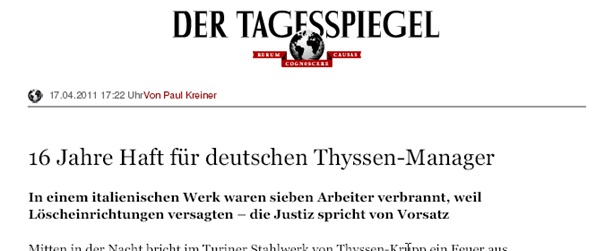Do not test your law system
20 April 2012 • John de Croon
asset management strategie, risk management
About a year ago the German newspaper ‘Tagespiegel’ published an article that intrigued me (on April 17, 2011 to be exact). I kept on thinking about the article so I decided to write a column about it and share it with you. I will first summarise what had happened.
In an Italian steel factory in Turin, which was part of the Thyssen-Krupp group, a fire broke out in the middle of the night in 2007. A fire can be annoying, but does not necessarily have to be dramatic. Smaller fires indeed can be common with only material damage. In a factory where liquid steel occurs, the probability of a fire is quite likely. In the summer of 2010 there was fire in a steel factory of Thyssen-Krupp in Krefeld, Germany. The insurance company had forced Thyssen-Krupp to improve the safety in its steel factories. Thus it happened ...... however in Turin the safety measures were not implemented as intended.
In the Turin steelworks, the managers had decided to appoint a ´fire prevention officer´, but that employee did not receive necessary training nor appropriate equipment. The employee was present when, two days after his appointment, a fire broke out at Line 5. There was no automatic extinguishing equipment and three of the five fire extinguishers did not work. The water provisioning was defect as well. There were eight workers, who tried to extinguish the flames the best they could. Then during the fire a hydraulic pipe erupted. Oil was released with a pressure of 140 bar and the consequences are obvious. There was a cloud of fire and seven of the eight workers were killed, including the newly appointed fire prevention officer. This was the worst accident that had occurred in Italy ever.

The manager of the Italian plant, Harald Espenhahn, was sentenced to sixteen and a half years in prison in April 2011. The jury found him guilty of premeditated murder. Five other Thyssen-Krupp managers have received prison sentences of between ten and thirteen years. In the relative article in the Tagesspiegel can be read that in Italy, with a communistically dominated trade union culture, the contradiction between labour and capital is large. Therefore the sensitivity against accidents is (even) much higher than is the case in Germany. The sentences were nevertheless heavily to Italian standards.
In the research a number of facts were found. At Line 5, 114 safety rules and regulations were violated. According to the judgment the management knew this and the management did thus sent the employees to their deaths. This while Harald Espenhahn already had received the money needed to implement the safety measures in response to the fire in Krefeld.
I asked myself ´how is it that such disasters can occur?´ And ´what can we do to prevent it?´
On the internet site www.nu.nl I read that ThyssenKrupp has reported that the safety of workers is as important as the quality of the products and the demand for profit. Suppose that this is the case, the question remains how this could have happened. Sometimes there is an unfortunate combination of circumstances resulting in an accident. But in this case there was no such coincidence. Here a time bomb is created. If safety requirements are not met in 114 cases, then you can wait for an accident to happen. Of course it was not the intention of the director to kill people, but he wittingly created the circumstances in his factory. So it could be expected that someone would get killed. And then you are awfully close to premeditated murder.
It is known that people perform certain behaviour when they have an advantage in a particular situation. Suppose that the involved managers received a bonus linked to the availability of the plant. Such a bonus can be in the range of tens of thousands Euros. However, it is (fortunately) also common that managers receive a bonus when a certain safety performance is achieved[1]. If it would be chosen to shut a plant (temporarily) down to improve safety, the plant manager has the certainty that he or she misses a bonus related to the availability. The occurrence of a safety incident is uncertain (a kind of lottery) and if it would occur, there is a chance that there are no casualties. On the other hand, in the risk matrices which I often see the death of a number of employees is in the category ‘unacceptable’.
Some lessons can be learnt. Make sure you have a risk matrix and apply it. If a risk is unacceptable, implement measures which mitigate the risks in both the short and long term to an acceptable level. Keep in mind that as a manager you can be tempted to choose the ´certain´ bonus while human lives are put at stake. No sane person wants to be in the position that under their responsibility people give their lives. An asset manager is not supposed to gamble. Safety always has priority to the extent that it is reasonably possible.
In other words: do not test whether the law in your country leads to the same results as it did in Italy!
[1] A KPI could be for instance LTIF or DART rate. LTIF = Lost Time Injury Frequency. DART = Days Away, Restrictions and Transfers
John de Croon is partner at AssetResolutions BV, a company he co-founded with Ype Wijnia. In turn, they give their vision on an aspect of asset management in a weekly column. The columns are published on the website of AssetResolutions, http://www.assetresolutions.nl/en/column
<< back to overview
|


